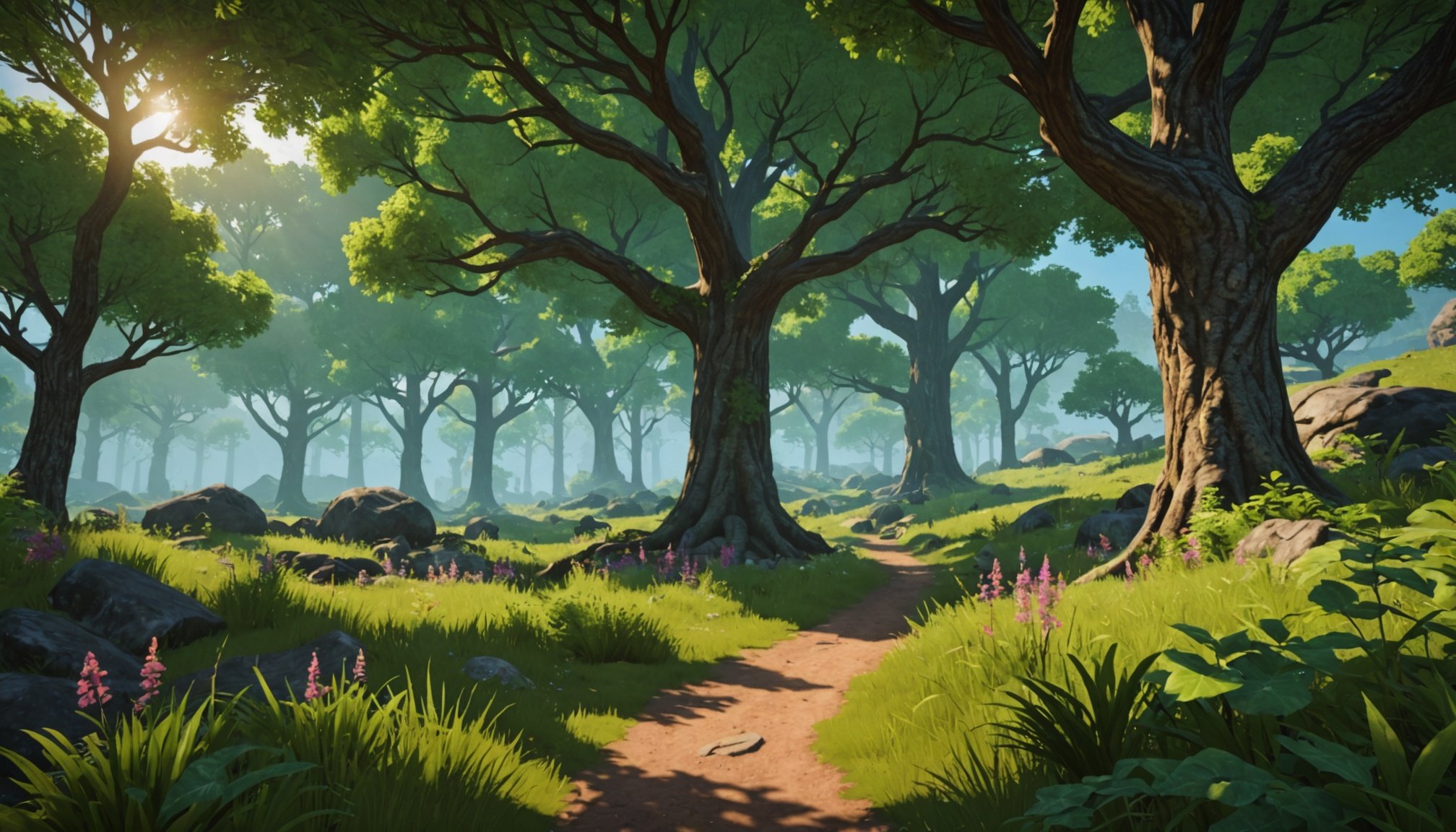Importance of Realistic Vegetation in Open-World Games
Realistic vegetation plays a crucial role in shaping the experience within open-world games. It transforms static digital landscapes into lifelike environments, significantly enhancing player immersion. The intricate details of flora, from the sway of trees in the wind to the underbrush crunching beneath the character’s feet, allow players to feel as though they truly inhabit these virtual worlds.
Incorporating realistic vegetation also impacts game design by influencing gameplay mechanics and exploration. Dense forests may conceal secrets or offer strategic cover, while fields might open up opportunities for spotting distant landmarks. Such intricacies enrich open-world games, making them more engaging as players navigate through varied terrains.
Topic to read : Transforming escape room adventures: leveraging ai for real-time puzzle challenge customization
Moreover, the connection between vegetation and the player’s emotional experience cannot be overstated. Lush greenery can evoke calmness, while arid deserts may instill a sense of urgency or survival. By appealing to players’ senses, game designers craft an emotional narrative that resonates as they explore.
In summary, realistic vegetation is not merely an aesthetic choice but a pivotal element of game design. It enhances immersion, enriches gameplay, and deepens players’ emotional connections within open-world games.
Topic to read : Amplifying terror: harnessing dynamic audio innovations to enhance immersion in horror gaming
Techniques for Modeling Vegetation
Modeling vegetation requires a deft touch and a deep understanding of various 3D modeling techniques. To create lifelike vegetation, one must select the most effective modeling software available. Programs like Blender and Autodesk Maya are popular choices, as each offers unique features that aid in the foliage creation process.
When it comes to creating diverse plant species, attention to detail is paramount. Start by researching the specific characteristics of the vegetation you wish to model. This will guide your vegetation modeling process and ensure authenticity in your creations. Focus on the texture, colour, and shape to achieve complexity and realism.
LOD (Level of Detail) techniques are vital for performance optimization, especially when dealing with high-density forests or large fields. By adjusting the detail level based on the viewer’s distance, you can maintain performance without sacrificing quality. For instance, nearby trees might use a high polygon count while distant foliage opts for lower detail models.
In practice, achieving a compelling result with vegetation modeling is a combination of selecting the right tools, applying 3D modeling techniques, and optimizing through LOD techniques. By balancing these elements, a seamless and immersive environment can be crafted.
Texturing and Shading Plants
Creating realistic environments in digital spaces demands careful attention to texturing plants and deploying effective plant shaders. These elements significantly affect a scene’s visual fidelity, providing a seamless transition between reality and virtual representation.
Texturing plants involves crafting detailed surfaces that convincingly mimic real-life foliage. This process is essential as realistic textures directly impact the viewer’s perception and overall immersion. High-quality texturing techniques vary depending on the plant species. For instance, broad-leafed plants might require different approaches compared to needle-like leaves, each demanding specific attention to detail such as tone, pattern, and translucency.
Implementing plant shaders is pivotal in achieving realism, particularly under varying lighting and weather conditions. Shaders determine how plants interact with light, simulating effects like shadow cast, highlights, and how the plant sways in the wind. Dynamic shaders can adapt to changing conditions, ensuring plants maintain their visual fidelity whether basked in sunlight or shrouded under cloud cover.
Incorporating advanced texturing and shading into digital plant design enhances the environmental realism, making virtual lands not just believable but breathtakingly lifelike. Embracing both static and dynamic components ensures that every foliage depicted aligns as closely as possible with natural perception.
Integrating Natural Behaviors in Vegetation
Got a green thumb, even in gaming? The art of simulating natural behaviors in video games is a rewarding challenge. One crucial aspect is creating believable environments where vegetation interaction is fluid and lifelike. Techniques involve environmental simulation like wind dynamics, which help mimic realistic plant movements. This not only enriches aesthetics but also deepens immersion.
Understanding how vegetation interacts with its surroundings is key. Sophisticated algorithms can simulate environmental factors such as sunlight, moisture, or even subtle air currents, allowing foliage to sway naturally. When done correctly, players feel like they’re truly walking through a living, breathing forest.
Incorporating dynamic vegetation goes beyond local winds. Plants might respond to player actions— like leaves rustling as one walks by or branches breaking underfoot. It’s about enhancing interactivity and realism, offering a more complete sensory experience to players.
Studying existing games uncovers successful examples. Titles like “The Witcher 3” showcase detailed vegetation behaviors, embracing natural interactions and elevating player immersion. Analyzing these can inspire techniques that capture the essence of nature, making virtual worlds more captivating. By learning from such cases, developers can push the envelope further in environmental simulation.
Recommended Tools and Software
When delving into game development, vegetation software plays a pivotal role in bringing environments to life. These tools help in modeling and texturing realistic plant models, necessary for creating immersive landscapes. Commonly used software such as SpeedTree and PlantFactory offer comprehensive solutions for vegetation creation. They provide user-friendly interfaces and robust customization options, making them indispensable in the industry.
Additionally, asset marketplaces serve as essential resources for obtaining high-quality plant models that can save time and enhance visual fidelity. Platforms like TurboSquid and CGTrader offer a vast library of models. Through these, developers can easily acquire pre-made assets created by skilled artists, streamlining the creative process.
Game development tools also require effective asset management to ensure efficient organization and use of resources. Tools like Unity’s Asset Store not only offer vegetation models but also provide an infrastructure for managing these assets within the game’s framework. When optimizing groundwork in game engines, it’s crucial to manage textures and models efficiently. Techniques such as level of detail (LOD) and culling ensure that only necessary assets are processed, enhancing both performance and visual appeal.
Case Studies of Successful Vegetation Implementation
Learning from case studies in open-world game development reveals insightful strategies for implementing realistic vegetation. By examining successful examples, developers can discern best practices that enhance both the aesthetics and functionality of game environments.
A notable trend in successful open-world vegetation design is the attention to detail and realism. For instance, well-known open-world games often incorporate diverse plant species and environmental interactions. These integrations are not just visually appealing but contribute to the immersive experience by reacting realistically to player actions and environmental conditions.
Moreover, analysing the lessons learned from both successes and setbacks provides valuable guidance. Failures often stem from overlooked details, such as repetitiveness in design or lack of environmental interaction, which can break immersion. Conversely, successes are typically marked by the ability to seamlessly blend vegetation into the game’s ecosystem, providing visual diversity and functional interactivity.
Specific titles have set new standards by using innovative techniques to enhance realism. These improvements not only uplift the gameplay experience but also elevate the visual storytelling. When vegetation design is thoughtfully executed, it can significantly enhance the player’s connection to the game world, leading to critical and commercial acclaim.










